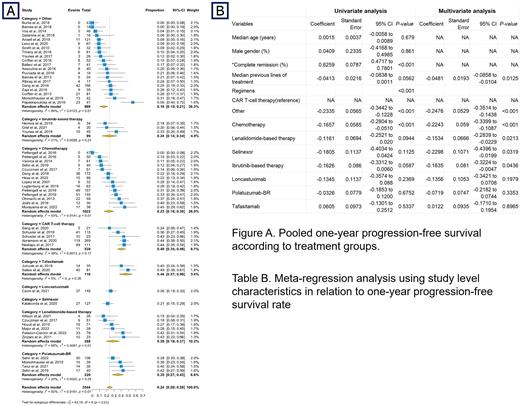Abstract
Background: Patients with relapsed/refractory (R/R) diffuse large B-cell lymphoma (DLBCL) who are ineligible for or failed autologous stem cell transplantation (ASCT) are known to have a grave prognosis. Several recommended treatments, including chimeric antigen receptor T-cell therapy (CART) by current guidelines, are available for this patient population, but identifying a better treatment remains elusive. We aimed to determine which study-level factors and a group of treatments affect clinical outcomes.
Methods: We performed a systematic review and meta-analysis to identify prospective phase II or III clinical studies evaluating the efficacy of treatments for ASCT-failed or ineligible R/R DLBCL. The MEDLINE, Embase, and Cochrane databases, as well as abstracts from international hematology congresses (ASH, ASCO, and EHA), were searched from inception to May 2022. Random effects models were utilized to estimate one-year progression-free survival rate, complete remission rate, and subgroup differences. Meta-regression models were performed with adjustment for relevant covariates, particularly the median number of previous lines of systemic therapy. CART was used as a reference treatment in meta-regression analysis.
Results: Overall, 56 cohorts from 50 studies comprising 3,544 R/R DLBCL patients were included in the pooled analysis. Treatment regimens were divided into nine groups: CART, chemotherapy, lenalidomide-based therapy, ibrutinib-based therapy, tafasitamab-based therapy, polatuzumab plus bendamustine and rituximab (pola-BR), loncastuximab, selinexor, and others. Others mainly consisted of treatments not included in the guidelines. The pooled one-year progression-free survival rate was 0.40 (95% confidence interval [CI] 0.35-0.46) for CART, 0.23 (95% CI 0.16-0.30) for chemotherapy, 0.28 (95% CI 0.19-0.37) for lenalidomide, 0.24 (95% CI 0.14-0.34) for ibrutinib, 0.46 (95% CI 0.37-0.56) for tafasitamab, 0.35(95% CI 0.27-0.43) for pola-BR, 0.26(95% CI 0.19-0.33) for loncastuximab, 0.21 (95% CI 0.15-0.29) for selinexor, and 0.16 (95% CI 0.10-0.21) for others (Figure A). CART was significantly better than others, chemotherapy, lenalidomide, selinexor, and ibrutinib, but loncastuximab, pola-BR, and tafasitamab were shown to have no significant different efficacy with CART, with adjustment for the median number of prior lines of treatment in meta-regression analysis (Table B).
Conclusions: Despite the fact that distinct groups were pooled and analyzed, tafasitamab showed the trend of best efficacy in this patient group, and CART did not demonstrate better effectiveness over tafasitamab, loncastuximab and pola-BR. Due to the study's heterogeneity, randomized controlled trials are needed to confirm these results.
Disclosures
No relevant conflicts of interest to declare.
Author notes
Asterisk with author names denotes non-ASH members.


